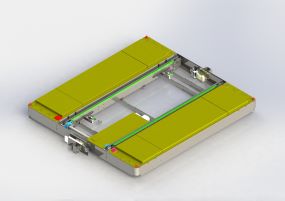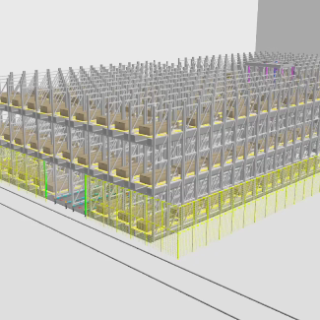For over 30 years, our mission has been to optimize internal transport in production plants. To meet our customers’ needs, we are launching our new product to the market – an automated guided vehicle (AGV).
An automated guided vehicle (AGV) follows a series of predetermined instructions, cues or signals to move around and complete actions, such as picking up or dropping off materials. For that reason, AGVs find application in intralogistics and manufacturing processes, or any other application that requires repetitive material handling tasks. We are specialists in field of heavy transportation, which is why our AGVs are designed to transport heavy loads.
Below we would like to present AGV with chain conveyor
Our automated guided vehicle with chain conveyor moves between unloading and loading points, picks up and releases loads. It enables horizontal transport of packages of high weight (up to 2.5 ton).
The autonomous FTSKWS trolley can move independently between loading and unloading along any path – in a straight line and in a curve, move in any direction and turn around its axis of symmetry thanks to the zero turning radius.
AGV’s advantages:
Efficiency
AGVs are a key component of supply chain automation because of its efficiency.
They can provide predictable, repeatable efficiency 24/7. AGVs predictability is crucially significant in those cases, where everywhere a company is struggling with hiring and retaining qualified workers. The high accuracy is not less important. The level of AGV precision possible is a direct result of a vehicle’s positioning accuracy (determined usually by its navigation system). Our AGVs are capable of achieving a positioning accuracy of approximately one centimeter, which is more than precise enough for most intralogistics and production applications.
Safety
AGVs are involved in radically fewer dangerous situations and accidents than their manually-operated subsitutes. Adopting AGVs will almost certainly mean fewer injuries, which might also lead to lower business insurance rates.
Savings
Even though the initial capital investment is higher than that of manual vehicles or transport trolleys, ongoing costs are typically much lower. Whys and therefores:
AGVs costs are more predictable than human labor costs, which can fluctuate significantly, especially in times of galloping inflation.
While moving in a steady, predictable way as well as accelerating and braking in a controlled manner, the automated transport vehicle needs less frequent service works. The components need
to be replaced less often than those of manual vehicles.
AGVs always follow programmed safety protocols, and thus they are much less likely to be damaged or cause damage to goods, transported materials or any other infrastructure.
Depending on the type of AGV, breakeven can be achieved in as little as a two or three years, sometimes even less. Contact us to find out about the time of return on investment in AGV in your company.

| Total Length | L | 2814 mm |
| Working height | H | 300 mm |
| Width | B1 | 2578 mm |
| Cart weight | Q | 1550 kg |
| Number of wheels | 8 | |
| Trolley speed | V1 | 1,2 m/s |
| Chain speed (linear speed of the package) | V2 | 12 m/min |
| Max. dimensions of the package being transported | LxB | 2600×1000 mm |
| Load unit | package | |
| Max load | 2500 kg |


